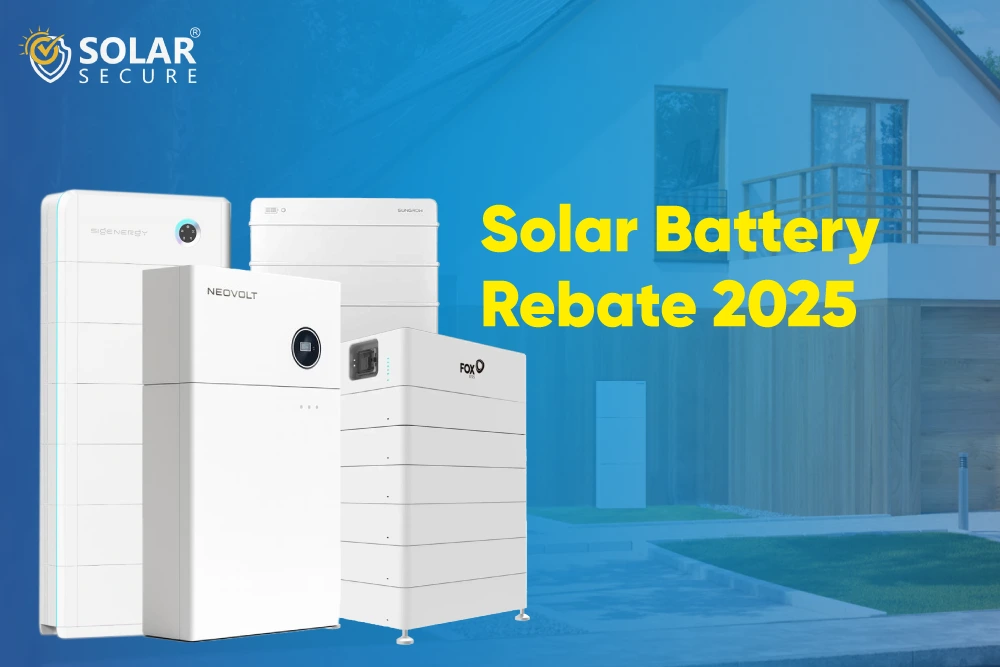Introduction: Why Solar Batteries Are Gaining Momentum in Australia?
Australia has been leading the way in solar energy for years. In fact, more than 3.5 million households now have rooftop solar, helping families cut down on electricity bills while relying less on fossil fuels.
But there’s still a catch: solar panels only work when the sun is shining. At night, most households are still dependent on grid electricity.
That’s where solar batteries come in. By storing the extra energy your panels produce during the day, a battery lets you use your own clean power after the sun goes down. This means more energy independence, better control over rising electricity costs, and even backup power during blackouts.
Recognising how important this shift is, the Australian Government is introducing the Federal Solar Battery Rebate in 2025. This rebate makes home batteries more affordable by reducing upfront costs, so more families can embrace the technology and enjoy long-term savings.
What Is the 2025 Federal Solar Battery Rebate in Australia?
The 2025 Federal Solar Battery Rebate is a key part of Australia’s push to speed up the shift to renewable energy. Its goal is simple: to make solar batteries more affordable for everyday households, so more families can store and use their own clean power.
From July 1, 2025, the government has launched the Cheaper Home Batteries Program, offering eligible households an upfront discount of around 30% off the cost of a home battery system.
What does that really mean for you? With today’s Small-scale Technology Certificate (STC) value sitting at about $36 (after admin costs), families can expect to save roughly $335 for every usable kilowatt-hour (kWh) of battery capacity installed. On a typical home battery, that can add up to thousands of dollars in savings.
The rebate won’t last forever, though. It will gradually reduce each year until the program finishes in 2030.
This initiative is powered by a $2.3 billion boost to the Small-scale Renewable Energy Scheme (SRES), the very same program that kick-started Australia’s rooftop solar boom. Now, it’s set to do the same for home batteries, helping more Australians cut bills, gain energy independence, and support a cleaner future.
Who Is Eligible for the Federal Solar Battery Rebate 2025?
Not every household automatically qualifies for the rebate. The government has set specific eligibility criteria to ensure support reaches the right families.
Income Thresholds and Household Criteria
- Households with an annual income below $180,000 are more likely to qualify.
- Priority is often given to low- and middle-income households to encourage equitable access.
- Owner-occupiers and landlords may be eligible, depending on state and territory rules.
Geographic Eligibility Across States and Territories
While the federal rebate applies nationwide, availability may differ depending on:
- State-level policies.
- Demand and funding allocations.
- Whether local energy providers are participating.
Types of Properties That Qualify
- Detached houses and townhouses.
- Some rental properties (with landlord approval).
- Small businesses may be eligible under separate schemes.
The program requires battery systems to meet specific technical and installation standards:
- Nominal capacity between 5 and 100 kWh
- Rebate applies to up to 50 kWh of usable capacity
- Must be brand new (no second-hand or refurbished batteries)
- Installed on-grid or off-grid (off-grid must be 1 km+ from main grid or face high connection costs)
- On-grid systems must be Virtual Power Plant (VPP) capable
- Paired with new or existing rooftop solar
- Battery and inverter must be on the Clean Energy Council (CEC) approved product list
Households can also claim the rebate when adding extra batteries to an existing solar system, if the system hasn’t already received the rebate. To qualify, the new battery capacity needs to be at least 5 kWh, and the total system size must stay under 100 kWh.
Common Rebate-Eligible Battery Brands in Australia
1. Tesla Powerwall 2 & Powerwall 3
Strongly approved across federal rebate and state schemes like VIC, NSW, SA
Features: ~13.5 kWh capacity, 10-year warranty, VPP compatibility
2. Sungrow (SBR & SBH Series)
Modular capacities (approx 9.6–25.6 kWh), high efficiency, 10-year warranty, VPP-compatible.
3. Alpha ESS (Smile Series)
Offers systems ranging 5–30 kWh, hybrid options, 10-year warranty, rebate-approved.
4. Sigenergy (SigenStor Series)
All-in-one energy management systems, modular up to large sizes; increasingly popular; rebate eligible.
5. Neovolt (Battery Series)
Flexible storage options (10–30 kWh), modular design, 10-year warranty, VPP-ready, ideal for Australian homes, rebate-eligible.
6. Growatt (ALP and APX Series)
Growatt (ALP Series)
Flexible modular storage (5–40 kWh), compact design, 10-year warranty, rebate-approved.
Growatt (APX Series)
High-voltage modular batteries (approx 5–30 kWh), safe and efficient, 10-year warranty, VPP-ready.
Receive STCs for installing a new battery
Like the government solar panel rebate, the battery incentive is issued in the form of Small-scale Technology Certificates (STCs).
Every kilowatt-hour (kWh) of battery storage will earn 9.3 STCs in 2025. The number of STCs will decrease with each calendar year.
| Year | STCs per kWh |
|---|---|
| 2025 | 9.3 |
| 2026 | 8.4 |
| 2027 | 7.4 |
| 2028 | 6.5 |
| 2029 | 5.6 |
| 2030 | 4.7 |
At this point in time, it is not anticipated that the battery scheme will extend beyond 2030.
The value of the solar battery rebate
Your chosen battery installer will trade your STCs for you to claim your rebate. Typically, STCs trade around the $40 mark. However, administrative costs effectively reduce the STC value to $37. To calculate the value of the rebate, we multiply 9.3 by $37 to arrive at $344 per kWh.
A 10-kWh battery will attract a rebate of $3,440.
The table below shows the anticipated rebate amount for various size batteries:
| Battery Size (kWh) | Approximate Rebate |
|---|---|
| 1 | $344 |
| 5 | $1,721 |
| 8 | $2,753 |
| 10 | $3,441 |
| 13.5 | $4,645 |
| 20 | $6,882 |
| 27 | $9,291 |
| 50 | $17,205 |
| 100 | $17,205 |
Combining rebates
It's possible to combine multiple rebates when purchasing a new solar panel and battery system. For example, you can receive rebates for:
- Solar panels (federal government)
- Solar batteries (federal government)
- State government battery incentives
The state and territory incentives work in unison with the federal battery subsidy. Most incentives revolve around interest-free finance.
The NSW government provides a rebate for connecting to a VPP while the WA government provides an additional saving for installing a new battery.
How Long Will the 2025 Federal Solar Battery Rebate Last?
Funding Limits and Deadlines
The rebate operates under a limited funding model. Once allocations are exhausted, households must wait for future rounds.
Why Apply Early Matters
- Early applicants secure the highest rebate value.
- Delays may reduce savings as funding phases out.
Why Choose Solar Secure for Your Solar Battery Installation?
Solar Secure stands out as a trusted provider of solar battery solutions in Australia, offering unmatched expertise and customer support. Here’s why choosing Solar Secure for your solar battery installation is a smart decision:
CEC-Accredited Installers: Our team consists of Clean Energy Council (CEC) accredited professionals who ensure your solar battery system meets all safety and quality standards.
Customised Solutions: We assess your energy needs and recommend the best battery options, ensuring you maximise your savings with the Federal Government Solar Battery Rebate 2025.
Top-Tier Products: We partner with leading solar battery brands like Tesla, Sigenergy, Alpha ESS, Neovolt, Sungrow, Growatt, providing you with reliable, long-lasting solutions. Top-Tier Products: We partner with leading solar battery brands like Tesla, Sigenergy, Alpha ESS, Neovolt, Sungrow, Growatt, providing you with reliable, long-lasting solutions.
Hassle-Free Rebate Application: Our experts guide you through the entire rebate application process, from eligibility checks to final claims, ensuring you don’t miss out on savings.
Transparent Pricing: Our quotes are detailed and transparent, with no hidden fees. You’ll know exactly what you’re paying for.
Excellent Customer Support: We are always available to answer your questions, provide maintenance advice, and assist with any technical issues after installation.
Sustainable Commitment: At Solar Secure, we are committed to promoting clean energy and helping Australian households reduce their carbon footprint. With Solar Secure, you can be confident in receiving a high-quality solar battery solution that maximises your energy savings while supporting Australia’s renewable energy goals.
Conclusion: Why Now Is the Best Time to Invest in Solar Batteries
The 2025 Federal Solar Battery Rebate in Australia is a golden opportunity for households to cut energy bills, boost energy independence, and support Australia’s clean energy transition. With combined federal and state rebates, upfront costs are lower than ever, making solar batteries accessible for more Australians.
If you’ve been considering solar storage, now is the time to act. Rebates are limited, and the earlier you apply, the more you stand to save. Whether it’s reducing your electricity bills, increasing property value, or contributing to a greener planet, the benefits of solar batteries in 2025 are simply too good for a future-proof solution.





